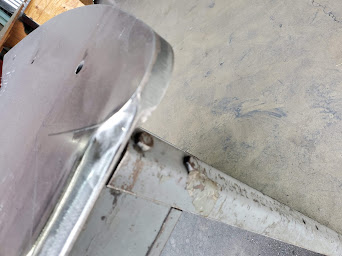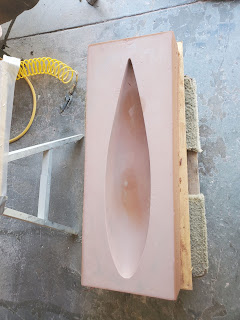Arcy Sparky
I didn't really get into the grinding of the shape of the keels before welding, here's a few pics.
All said and done, it took about nine minutes of lasering, five hours of milling (setup and cutting) and about two hours of grinding per keel. All ballpark numbers, but it's not off by a lot. The milling is pretty monotonous, in that you pretty much set it up and crank handles, and it doesn't take much thought once you figure out the numbers. The grinding is more "artistic" because it takes some feel and a fair bit of patience and a lot of paying attention to not go crazy and grind a bunch of hollows into it that you have to fix.
At the end of the last update, I mentioned that the welding of the keel was next. Well, Jim at Danrich Welding and his guys Jaime and Juan took care of us. They did a fantastic job of setup and welding. There's no possible way that I can write enough words to describe the process. Let the pictures speak for themselves...
 |
| Stitch welds and beginning of first pass |
 |
| That's a lot of weld |
 |
| Finish welded keel |
Once the keel's welded, we had to take it to a certified scale to be weighed. The simplest place for us was the Balboa Angling Club. The welded keel fin and top plate needed to weigh in at at least 233 pounds per class specs. It weighed in at 235.6 pounds, which is about as close as we could hope to get it. We needed to use 5/8" steel because 15mm steel is hard to get here, so we suspected that we'd be about 11 lb overweight. I'm not sure why it's lighter, but the fact that it's close to the minimum is perfect by me.
When our keels left the weighing operation, I delivered them straight to the guys who are going to spray galvanize them (zinc coating). The keels should be finished sometime before 1/1/2021.
The plywood kits should show up sometime between Christmas and New Years' Day.
Title inspired by David Hobbs, F1 Commentator
UPDATE:
Keel is galvanized. We chose to galvanize them, but it seems that there's some debate whether this is a good idea or necessary. Galvanizing is how we protect anchors from rusting. For us it's really a backup in case the epoxy barrier coat and bottom paint get gouged so badly that the zinc/steel are exposed. They're spray galvanized.








Looks great!
ReplyDeleteI'm so in awwwwww! I'm so happy I'm buying mine from you
ReplyDelete